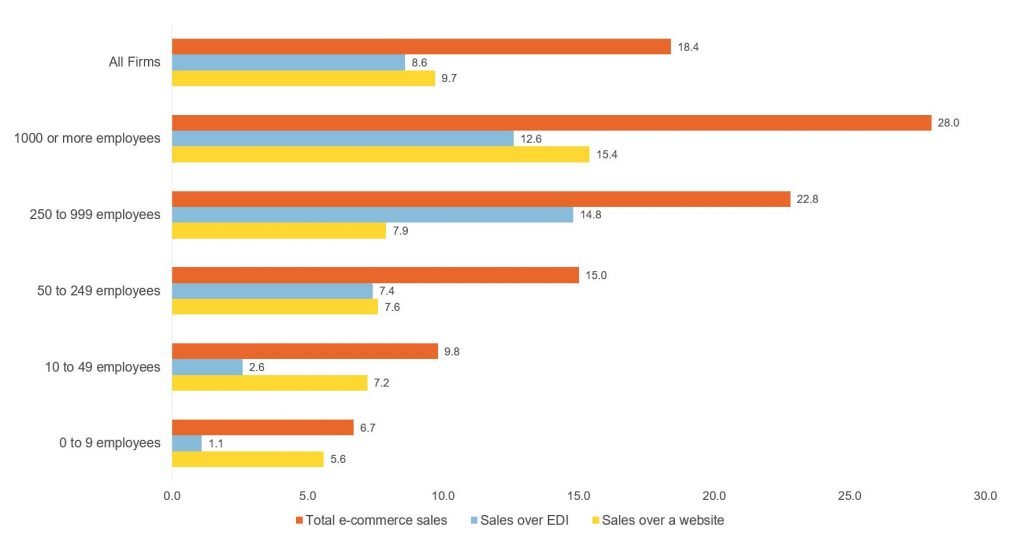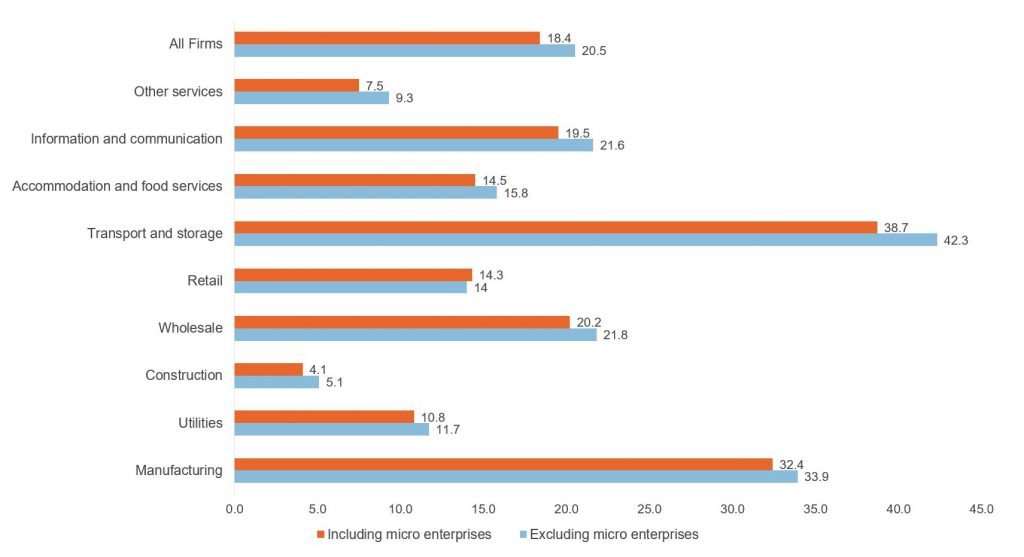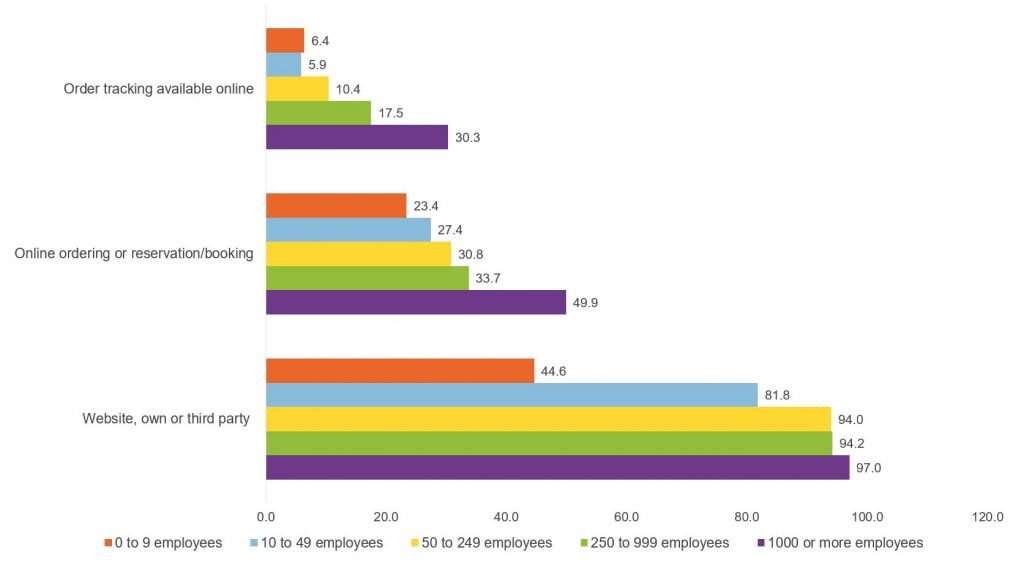The shift to online shopping prompted by Covid-19 restrictions presents a challenge for businesses, particularly those that are not used to e-commerce. Small firms and micro enterprises can clearly benefit from digital technologies, but many struggle to compete in online markets.
Recent statistics for the UK and other European countries (Office for National Statistics, ONS, and Eurostat, 2019) reveal that small and medium-sized enterprises (SMEs) have considerably lower readiness to sell online compared with large businesses. There is a further gap between SMEs and micro enterprises, two categories of firms collectively labelled MSMEs.
Given the potential benefits that e-commerce entails – in terms of both market access and cost savings, which can make firms more resilient to crises – it is worrying that small and micro enterprises appear to be falling behind. It is likely that this has contributed to the closure of a large number of small businesses over the last few months (Facebook, OECD and World Bank, 2020).
What does the evidence from economic research tell us?
E-commerce accounts for an ever-larger share of total turnover in the UK: 18.4% in 2018, up from 16.6% in the previous year. This trend is likely to be accelerated by Covid-19 (Coyle and Nguyen, 2020). But micro and small businesses also realise a smaller share of their total turnover from selling online compared with larger ones. Figure 1 shows that only 6.7% of the turnover of micro enterprises (those with fewer than ten employees) is derived from e-commerce. While this share is higher for small enterprises (those with 10-49 employees), it is still below 10%.
This share increases to 15% for medium-sized enterprises (those with 50-249 employees), and to over 20% for firms with more than 250 employees. Moreover, the lower use of electronic data interchanges (EDI) by smaller firms indicates a focus on final consumers, rather than selling to other businesses.
Figure 1: E-commerce sales in the UK by firm size (2018, percentage of total turnover)

Source: Office for National Statistics; and authors’ elaboration
The share of e-commerce in total turnover also differs considerably across sectors (see Figure 2), ranging from around 40% in transport and storage to less than 5% in construction. While a full breakdown by firm size bands is not available, it is possible to exclude micro enterprises. This reveals that in all sectors apart from retail, smaller firms derive a smaller share of their turnover from e-commerce activities.
There are many possible reasons for the low incidence of online sales by micro businesses, but one could be that less than a half of them have a website in the first place (see Figure 3). While there are likely differences across sectors, this is a striking difference compared with larger firms. For example, 82% of firms with 10-49 employees operate a website and this increases to more than 90% for those employing more than 50 people.
What is more, among those micro and small enterprises that have a website, fewer take orders or bookings online or provide customers with the ability to track their order, two features that are providing considerable benefits to customers. These findings are confirmed by a cross-European survey, which also shows that while SMEs in the UK consider digitalisation a top priority, access to employees with digital skills is a barrier to increased e-commerce activity (European SME Survey, 2019).
Figure 2: E-commerce sales in the UK by industry sector (2018, percentage of total turnover)

Source: Office for National Statistics; and authors’ elaboration
Figure 3: Use of websites and e-commerce tools in the UK firm by size (2018, percentage of total)

Source: Office for National Statistics; and authors’ elaboration
Note: The first two series consider only firms reporting that they have a website
Based on the trends examined here, it is likely that larger firms were in a much better position to exploit the large and sudden shifts to online shopping arising from Covid-19. This is supported by the fact that large online retailers such as Amazon could increase their market valuation by 40% since January 2020 (Reggiani et al, 2020).
But a recent study finds that 16% of SMEs developed or increased their existing online presence during lockdown by the end of April 2020, and 24% increased their use of digital technologies to facilitate working from home (FSB, Federation of Small Businesses, 2020). The latter point matters as the failure to adopt of information and communications technologies (ICT) and develop digital skills can be a key barrier to a firm’s readiness to turn online.
SMEs in the UK are often aware that they could use digital technologies more effectively (for example, for digital marketing and e-commerce), but they face time constraints due to other more pressing priorities as well as a general shortage of digital skills in the labour market (UK Commission for Employment and Skills, 2016).
Other barriers for UK SMEs include tight budgets and a lack of willingness and knowledge to invest in and adopt digital technologies (IDC, 2017). In fact, only 20% of UK SMEs view ICT as a driver of competitive advantage, and 35% see it as an enabler of business efficiency. Figures for micro enterprises are even lower as a large fraction is worried about the potential risk of undertaking digital business models.
While UK enterprises derive a higher share of turnover from e-sales compared with the European average (Eurostat, 2019), only 7% of UK firms made web sales to European Union countries, compared with 15% in Ireland and 12% in Belgium. Eurostat (2019) also highlights high delivery costs, foreign languages, adapting product labelling and judicial reasons as key obstacles for cross-border e-commerce. A recent report shows that only 9% of UK SMEs are engaged in international trade (British Business Bank, 2020) and that adoption of digital technologies are a key enabler of exporting (European SME Survey, 2019).
These figures depict a mixed departure point for many small and micro enterprises in the UK to move towards selling online during the Covid-19 crisis. This is concerning in a context in which even cross-border e-commerce is estimated to have grown by more than 10% between January and April 2020 (Global-E, 2020), and where consumers in the UK and other European countries are increasingly engaging in online shopping.
Indeed, one recent study finds that in the UK, France and Germany, consumers are making over 50% of their purchases online, and 60% plan to remain shopping online for both essential and non-essential goods after the pandemic (Kantar, 2020). In addition, recent ONS figures reveal that online sales in the UK hit a record high of 33.4% of total retail sales in May 2020 (ONS, 2020).
How reliable is the evidence and what else do we need to know?
While small and micro enterprises account for 95% of enterprises and 60% of employment worldwide (World Trade Organization, WTO, 2020), they are not easy to track via surveys or other official data sources. There is thus a risk that we do not have a good understanding of their current state and needs. For example, the Eurostat ICT survey only covers firms with ten employees or more, and the European SME Survey only firms with 20-250 employees. Hence, some findings for the UK need to be interpreted carefully, since micro enterprises particularly could be underrepresented due to a lack of data.
The ONS started to provide differentiated statistics for firms with fewer than ten employees in 2014, but still little is known about them – for example, sectoral statistics are still only available at a highly aggregated level. What is clear is that the ability to distinguish e-commerce performance by SMEs across industries is essential for evidence-based policy-making. Other measures that are needed include indicators of the barriers that MSMEs face in their transition to e-commerce, including variation across UK regions.
Finally, the timing of statistics is an issue as the latest ONS figures date back to 2018, with more recent data only due to be released in November 2020. As Covid-19 is a very recent and sudden shock, which has already had a strong impact on consumption patterns and the value that consumers place on online goods and services (Coyle and Nguyen, 2020), much more recent data are needed. There is a real concern that the current crisis will lead to the closure of many small and micro businesses that account for a large percentage of the UK’s employment (Financial Times, 2020 and FSB, 2020).
Several studies make policy recommendations with the aim of ensuring that e-commerce can serve the public in a safe way. This includes training for small and micro enterprises on how to trade safely online (World Bank, 2020). Others highlight that digitalisation can help small businesses to overcome the damage in supply chains caused by Covid-19, by accessing a wider range of buyers and suppliers (WTO, 2020).
On the upside, the WTO brief mentions the UK as an example of countries that have introduced measures to encourage small and micro enterprises to adopt ICT to improve their resilience to downturns and diversify their trading partners.
Information on government initiatives to support the use of e-commerce by MSMEs is limited. Much more evidence is needed on coverage and success of policy measures and to what extent small entrepreneurs are aware of them. Previous surveys of SMEs in Southeast England have found that they were largely unaware of existing policy instruments with the aim of helping them to adopt and use ICT (Harindranath et al, 2008).
In addition, action from the government is required to support small businesses to anticipate and address potential risks of e-commerce. A recent study reveals that small firms in the UK have suffered from malicious or fake reviews (20%), sudden changes of terms and conditions (19%) and infringement of intellectual property (13%) when trading online (FSB, 2020).
Where can I find out more?
- E-commerce and ICT activity, UK: 2018: This ONS report assesses the use of ICT and the value of e-commerce activity by UK businesses.
- State of digitalisation of UK business: This joint report contributes to the debate on how to improve productivity in the UK by evaluating the state of digitalisation of UK businesses.
- Going digital: The challenges facing European SMEs: This report analyses the results from the European SME Survey 2019 on attitudes towards digitalisation.
- Global state of small business report: This joint work by Facebook, OECD and the World Bank presents the findings from The Future of Business Survey, which aims to develop a better understanding of the impact of this crisis on small and medium-sized businesses.
- Recommendations to leverage e-commerce during Covid-19 crisis: This World Bank policy brief proposes a set of measures that governments can take in the short run to support e-commerce during the Covid-19 crisis.
- Helping MSMEs navigate the Covid-19 crisis: This WTO policy brief outlines the state of micro, small and medium-sized enterprises worldwide and lists policy recommendations to contribute to MSMEs’ resilience to crises like Covid-19.
- New horizons: How small firms are navigating the Covid-19 crisis: This FSB study provides insights on how UK small businesses are coping with the Covid-19 crisis in several aspects, and what measures the government can undertake to support them.
Who are UK experts on this question?
- Stephen Roper, Warwick Business School
- Cecil Prescott, Office for National Statistics
- Tim Vorley, Oxford Brookes Business School
- G. Hari Harindranath, University of London









































